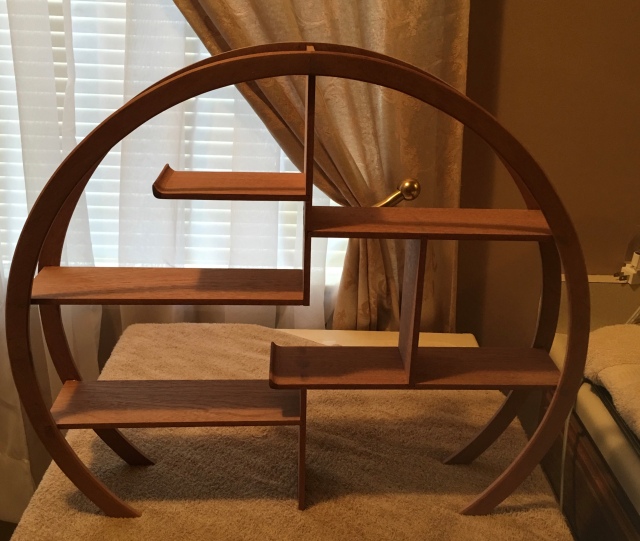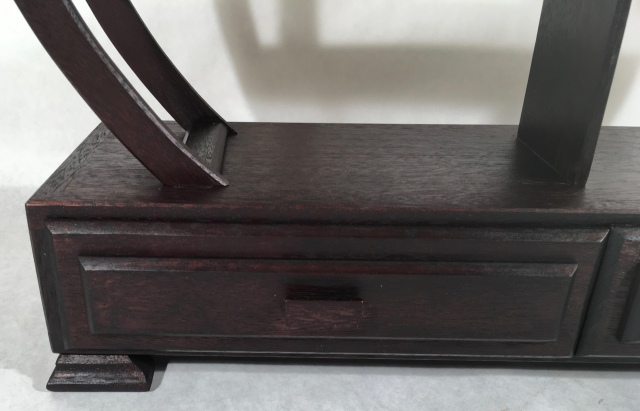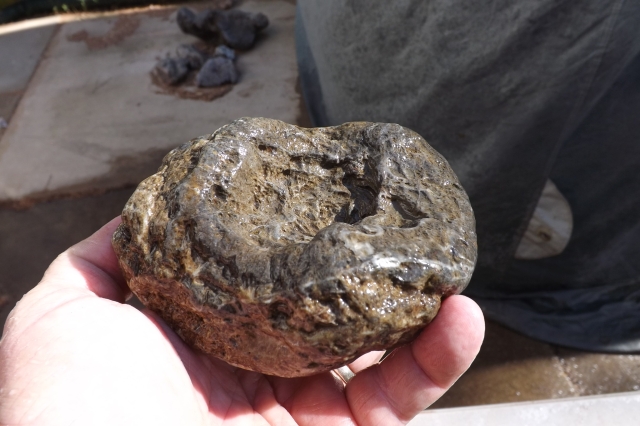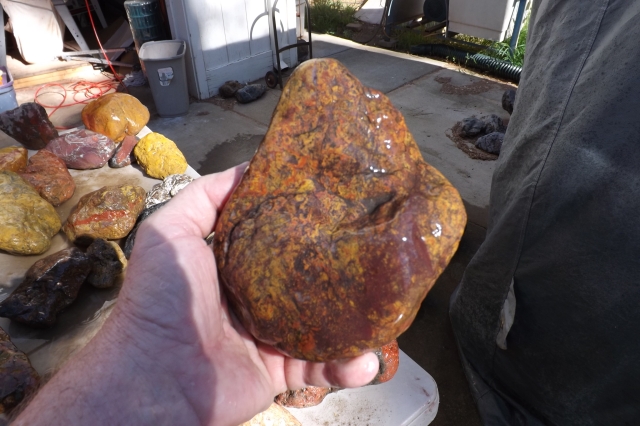A large list of classification of stones from another site.
Japanese Suiseki
Classification
The words “viewing stone” and “suiseki” are often used interchangeably in the Western world. However, they are not the same. The Japanese Art of Suiseki is much more refined and defined. In the study, collection, and appreciation of stones as art, we must understand that there is a clear distinction between the cultural forms of stone appreciation.
Japanese Suiseki criteria formed the basis for defining the characteristics of our Western stones. Likewise, Suiseki classification is also the international criteria for stone recognition and naming used throughout the world.
One of the key aspects of this art form is the suggestability of the stones. True suiseki should “suggest” something to the viewer, yet not be a precise miniature representation of the object. This suggestibility may come from a memory, a feeling, or recognition of a special place or mountain. It could be a waterfall, a house, an animal, or a person. Sometimes the special stone has a shape that represents nothing in particular, but the texture of the stone or its patina evokes special feelings, emotions, or recognitions.
In their book, The Japanese Art of Stone Appreciation; Suiseki and Its Use with Bonsai, Dr. Covello and Mr. Yoshimura discuss the classical systems of grouping suiseki. In these multiple systems, stones are grouped by shape, color, surface pattern, or place of origin. Some Japanese collectors use only one of these systems, while others use a combination of several. Personally, I always like to know where stones originate in the hope that I can one day visit that area and search for my own.
I have used the systems described in The Japanese Art of Stone Appreciation; Suiseki and Its Use with Bonsai as the basis for the research I have done to determine the various acknowledged types of Suiseki. Additionally, I have found other types of stones or subclassifications described in Melba L. Tucker’s Suiseki & Viewing Stones, An American Perspective, and in Waiting to be Discovered, the North American Viewing Stone Society’s quarterly publication, edited by Jim Hayes – (no longer in publication). And I have run across many other classification names here and there as I performed research. All of those are included here.
Before beginning, it is best to have some understanding of general suiseki-related Japanese terms. The following is a short list.
bako (storage box. Kiri bako is the type used to store stones and their daiza – traditionally made of Paulownia wood due to its lightness and ability to protects from moisture.)
dai (stand, rack or rest)
daiza (form fitting stand or base)
doban (shallow metal, usually bronze, tray without holes in the bottom)
gata (shape or shaped)
ishi (stone)
jiita (thin hardwood boards placed under suiseki (or bonsai) for display)
kei (scenery)
san (mountain)
seki (stone)
shoku (small wood table used for display of art objects such as suiseki)
sui (water)
suiban (shallow ceramic tray without holes in the bottom)
CLASSIFICATION BY SHAPE
When stones are classified by shape, there are two primary sub-classifications. Stones may be scenic landscape stones (natural aspects of landscape) or they may be object stones (living and man-made creations).
Sansui kei-seki/Sansui keijo-seki (Scenic landscape stones). Stones in this category suggest natural landscape scenes that we would find in nature.
– Yamagata-ishi (Mountain stones). These stones may resemble a single mountain or several mountains. Although distant and near-view mountain stones are the most important sub classification, mountains may also be identified in other ways such as by the number of peaks.
— Toyama-ishi/Enzan-seki (Distant mountain stones). Resemble mountains as viewed from a great distance.
— Kinzan-seki (Near-view maintain stones). These appear as mountains viewed up close.
— Koho-seki (Single-peak stones). Mountains with only one peak.
— Soho-seki (Double-peak stones). Appear as two mountains, or a single mountain with two peaks.
— Sampo-seki (Triple-peak stones). Mountains with three separate peaks.
— Rempo-seki (Mountain range stones). These stones represent a range of mountains rather than a single mountain with one or more separate peaks.
— Seigaku-seki (Rugged Mountain stone). These are mountain stones which have features that make them look exceedingly rugged.
— Sekkei-ishi (Snow-covered mountain stone). Mountain stones that have snow like minerals at the peak(s) or on their sides.
– Taki-ishi (Waterfall stones). These stones resemble a mountain with one or more waterfalls. The waterfall is suggested by a streak of white mineral emanating from near the top of the stone and coming down the front. If the waterfall appears on both sides of the stone it is usually not considered a good stone. There are several specific types of waterfalls that are recognized.
— Itodaki-ishi (Thread-waterfall stones). Suggested by a thin line of quartz-like material running down the front of the stone.
— Nunodaki-ishi (Sheet-waterfall stones). These have broader lines of light-colored material coming down the front side of the stone.
— Karedaki-ishi (Dry waterfall stones). These are stones that have definite markings that suggest a waterfall that has dried up.
— Yamagata-taki-ishi (Mountain waterfall stones). Such stones meet the basic requirements of Mountain stones with the added feature of one or more waterfalls appearing on their front surfaces.
— Keiryu-seki (Mountain-stream stones). The suggestion of a mountain stream appears as though running through a gorge or valley. The effect is enhanced if there is a white mineral vein running along where the stream would be. Such stones are most ideal if the stream runs diagonally across the stone, rather than from front to back.
– Dan-seki/Dan-ishi (Plateau stones). Plateau stones suggest a terraced hillside or a series of flat steps rising toward a cliff. A classical stone would have at least three steps, which would vary in length. The rise between each step should be vertical or nearly vertical.
– Shimagata-ishi (Island stones). As the name implies, these stones resemble an island rising out of the water. They are traditionally low in height and ideally have features that suggest coves or inlets. These stones are normally displayed in a suiban or doban filled with sand or water to enhance the island image of the stone.
– Doha-seki/Doha-ishi (Slope stones). These stones suggest the rolling hills of a plain or a slope gently rising toward a hill.
– Isogata-ishi (Shore stones). Such stones are usually shallow and suggest a rocky shoreline. There are two primary subcategories.
— Araiso/Araiso-ishi (Reef stones). Rough stones suggesting a jagged reef or shoal.
— Hirasu/Hirasu-ishi (Sandbar stones). Smooth stones suggesting a sandbar or quiet beach.
– Misaki-ishi (Cape stones)
– Mizutamari-ishi (Waterpool stones). These stones have depressions that suggest mountain pools or ponds. Porous stone that do not allow the pool portion of the stone to be filled with water are not prized. The most highly prized pool stones are those with the pool encircled by one or more well-formed mountains.
– Tamari-ishi (Pool or Lake stones). These are similar to waterpool stones except the depressions suggest lakes or deeper pools than the shallower waterpools.
– Mizutame-ishi (Waterpuddle stones). Similar to waterpool stones, these have very shallow depressions that hold water.
– Iwagata-ishi (Coastal rock stones). These stones suggest a high, wind-swept rocky coastline; a tall, roughly shaped offshore rock; or a steep cliff at the end of a peninsula. Stones with white mineral deposits at their base are especially prized, since these markings suggest waves breaking against the cliffs.
– Dokutsu-ishi (Cave stones). The hollows and cavities in these stones resemble caves, caverns or grottos. The cave is ideally suggested by a deep and dark cavity, the end of which cannot be seen. The most admired cave stones are those where the cave slants sharply to the left or the right.
– Yadori-ishi (Shelter stones). The concave shape of these stones suggest a shallow shelter or temporary refuge formed by an overhanging cliff. To be classified as a shelter stone, the floor of the shelter should be at least partly visible.
– Amayadori-ishi (Rain-shelter stones). These are essentially the same as shelter stones except that you can more easily imagine the shelter protecting from rain.
– Domon-ishi (Tunnel stones). The hole or holes in these stones suggest a pass-through tunnel or natural arch. Traditionally, the tunnel passes completely through the stone.
Keisho-seki (Object stones). Stones in this category resemble objects closely associated with nature. The finest stones do not exactly copy the object, but suggest it through a few subtle lines and forms. There are eight traditional categories under this heading.
– Yagata-ishi (House-shaped stones). These stones suggest various types of rustic houses. The emphasis here is on “rustic”. A stone that resembles a typical American home, although potentially interesting, would not be regarded as a suiseki. Or certainly not one of value.
— Kuzuya-ishi (Thatched-hut stones). Thatched-hut stones form an especially important category within this group. Ideally the stone has an overhanging rounded or triangular roof and an eroded or recessed center. If the stone appears to have pillars holding up the roof, it is normally more valued.
– Funagata-ishi (Boat-shaped stones). These stones resemble different types of boats, including wooden sailing ships, rowboats, and houseboats.
– Hashi-ishi (Bridge-shaped stones). As the name suggests, these stones resemble a stone or wooden bridge.
– Dobutsu-seki (Animal-shaped stones). Any stone which resembles an animal would fall into this category.
– Torigata-ishi (Bird-shaped stones). This group of stones resemble real and mythcal birds.
– Mushigata-ishi (Insect-shaped stones). Most popular subjects within this category would be butterflies, dragonflies, crickets and grasshoppers.
– Uogata-ishi (Fish-shaped stones). Although all fish belong in this category, koi and goldfish are especially prized by collectors.
– Sugata-ishi/Jimbutsu-seki (Human-shaped stones). The most popular subjects for these stones include fishermen, farmers, maidens, Buddha, and Buddhist monks. Stones that suggest parts of the human body are also included in this grouping.
– Sankeishi-seki (Three objects stones). These stones suggest three different objects when viewed from different angles.
CLASSIFICATION BY COLOR
In this system suiseki are classified by their color. They are set aside from other suiseki by their deep, subdued, and excellent color. The stone is appreciated both for its color and what the color suggests (dawn, dusk, night, spring, sunsets). Color stones (Shikisai-seki) must still remain aesthetic and suggestive.
Kuro-ishi (Black stones)
Maguro-ishi (Jet-black stones)
Aka-ishi (Red stones)
Ao-ishi (Blue stones)
Murasaki-ishi (Purple stones)
Ogon-seki (Golden-yellow stones)
Kinko-seki (Yellow-red stones)
Goshiki-ishi/Goshiki-seki (Five-color stones). Traditionally these stones are a mixture of red, yellow, and green together with either gray, blue, purple, white or black.
CLASSIFICATION BY SURFACE PATTERN
In this system suiseki are classified by their surface patterns. Pattern stones (Mon’yo-seki; sometimes Mon-seki) are set aside from other suiseki by the striking surface patterns formed by the stone’s textures, colors, lines, embedded minerals, and other features. Japanese collectors have traditionally preferred patterns closely associated with nature.
-Kigata-ishi (Plant-pattern stones). Literally, tree-pattern stones. The surface patterns on these stones resemble a tree, plant or parts of a plant.
–Mori-ishi (Forest-pattern stones). These have surface patterns that resemble numerous trees, as a forest.
–Bonsai-pattern stones (Bonsai-ishi). These stones have a surface pattern that resembles a bonsai tree and pot.
–Hanagata-ishi (Flower-pattern stones). Patterns on these stones suggest types of flowers. Two categories of Flower-patterns are especially prized in Japan.
—Kikumon-seki/Kikka-seki/Kiku-ishi (Chrysanthemum-pattern stones). The patterns on these stones suggest the radial design of the chrysanthemum flower. Such stones are highly regarded by both American and Japanese collectors. The chrysanthemum is a traditional Oriental symbol of immortality.
—Baika-seki (Japanese plum-blossom-pattern stones). These stones have patterns that resemble Japanese plum blossoms.
—Nobara-ishi (Wild rose-pattern stones). These stones have surface patterns that suggest wild roses.
–Migata-ishi (Fruit-pattern stones). The surface patterns on these stones suggest different types of fruit.
–Hagata-ishi (Leaf-pattern stones). The surface patterns of these stones suggest different types of tree or flower foliage.
–Kusagata-ishi (Grass-pattern stones). These have patterns that suggest different types of grasses, including bamboo and pampas grass.
-Gensho-seki (Celestial-pattern stones) These stones suggest different objects in the day or night sky.
–Tsukigata-ishi (Moon-pattern stones). These stones have inclusions or embedded minerals which resemble the moon.
–Higata-ishi (Sun-pattern stones). These have markings or embedded minerals which remind one of some aspect of the sun; setting, rising, or fully displayed.
–Hoshigata-ishi (Star-pattern stones). The surface patters of these stones remind one of stars in the sky.
-Tenko-seki (Weather-pattern stones). Stones in this subcategory remind one of various weather related phenomenon. The three identified below are the most common, but others are possible.
–Amagata-ishi (Rain-pattern stones). These stones have inclusions or patterns that remind one of driving rain, usually coming down at an angle.
–Yukigata-ishi (Snow-pattern stones). Stones in this group resemble various patterns of snow falling.
–Raiko-seki (Lightening-pattern stones). Usually dark stones with white mineral deposits that resemble lightning bolts striking across the sky.
-Chusho-seki (Abstract-pattern stones). Although patterns in this category are abstract, they often suggest a subject closely associated with nature.
–Tori-ishi (Tiger-stripe-pattern stones). Stones with alternating strips of color, suggesting the stripes of a tiger.
–Itomaki-ishi/Itogaki-ishi (Tangled-net-pattern stones). The crisscrossing lines on the surface of these stones often suggest a tangled fishing net.
–Sudachi (Pit-mark-pattern stones). These stones are pockmarked with tiny pits or depressions. The pit looks as if they were formed by small needles or by the action of particles of sand grinding into the stone.
–Jagure (Snake-pattern stones). These stones have curving and winding patterns on the surface that suggest the writhing movements of a snake.
–Moniri-ishi (Embedded stones). These stones have abstract patterns embedded in their surface that are pleasing but do not suggest specific objects.
CLASSIFICATION BY PLACE OF ORIGIN
Nearly all Japanese collectors, and a growing number of western collectors, classify suiseki by their place of origin; moreover some Japanese collectors and books use only this system.
Locations in Japan that are especially famous as suiseki collecting sites.
Kamogawa-ishi (Kamogawa river stones). Jet black Distant mountain or Slope stones found in the Kamogawa river in Kyoto prefecture.
–Kurama-ishi (Kurama stones). Brown granite Island, Distant mountain, or Object stones found around the Kamogawa river, Kyoto prefecture. Also gray or brown limestone Tangled-net pattern stones.
–Kibune-ishi (Kibune stones). Dark gray or reddish-purple Mountain, Waterfall, or Mountain-stream stones found around the Kamgawa river.
Setagawa-ishi (Setagawa river stones). Black Mountain, Slope or Tiger-stripe pattern stones from around the Setagawa river in Shiga and Kyoto prefectures.
Nachiguro-ishi (Nachiguro stones). Jet-black Mountain or Plateau stones from the mountains of Mie prefecture.
Kamuikotan-seki/Kamuikotan-ishi (Kamuikotan stones). Black or blue-green Mountain, Slope, or Plateau stones from the rivers and streams of Hokkaido prefecture.
Sado akadama-ishi (Sado red stones). Red Mountain or Island stones from the mountains of Niigata prefecture.
Ibigawa-ishi (Ibigawa river stones)Black, bluish-black, or gray Coastal, Island, Waterpool, Shelter, or Waterfall stones from the rivers and streams of Gifu prefecture.
Sajigawa-ishi (Sajigawa river stones).Black, bluish-black, or gray Coastal, Island, Waterpool, Shelter, or Waterfall stones from the rivers and streams of Tottori prefecture.
Furuya-ishi (Furuya stones). Black or gray-black Mountain, Waterfall, Mountain-stream, or Coastal stones from the mountains of Wakayama prefecture.
Seigaku-seki (Seigaku stones). Black or gray-black Mountain, Waterfall, Mountain-stream, or Coastal stones from the mountains of Shizuoka prefecture.
Neodani-ishi (Neodani stones). Several stone types including Chrysanthemum-pattern stones of Gifu prefecture.
Some locations in the United States especially famous as suiseki collecting sites.
Sabaku-ishi (Desert stones)
Mojave Desert stones, California, USA
Murphys stones, Murphys California, USA
Some locations in Italy especially famous as suiseki collecting sites.
Ligurian stones, Ligurian Alps, Italy. Hard limestone. Similar geological composition to Furuya-ishi. In Italian such stones are referred to as ‘Palombini’ because of their blue-gray color similar to a pigeon (palombo).
NOTE: As a side note, viewing stones are called ‘living stones’ (le pietre vive) in Italy. – Marco Favero
Suiseki labeling. According to Covello and Yoshimura, most Japanese collectors of suiseki label their stones using one or more of the classification systems already described. Rarely are all four systems used. When more than one system is used, labeling is done in the following order:
Place of origin
Surface pattern
Color
Shape
A poetic name is often included after the last classification name.
Suiseki collectors in other countries generally assign less importance to the stone’s place of origin, and often list classificatory names in the following order: shape, color, surface pattern, place of origin, and poetic name. My observations of suiseki exhibitions indicate that most American suiseki simply use shape or surface pattern as the classification, sometimes adding place of origin. Few American suiseki have poetic names, however the number are growing. That is essentially what I use: poetic name (if any), shape or surface pattern (in both English and Japanese), and place of origin. When describing a picture of a suiseki I also add; dimensions of the stone, mineral composition when known, wood source of dai, and who carved the dai.
In addition to the classificatory terms already noted, Dr. Covello and Mr. Yoshimura provided four specialized terms used by Japanese collectors. These identify enhanced stones and suiseki of particular significance.
Biseki (lit., beautiful stone): These are not considered true suiseki. However, due to their rarity and beauty, they are displayed in the same manner as suiseki and are often shown together with suiseki at exhibitions. Biseki are stones that have been polished to enhance their natural beauty or color, or carved to bring out a particular feature such as an embedded flower pattern. Biseki do not need to have a suggestive shape.
Meiseki (lit., famous stone): These are the most perfect stones in one category or another. Such stones are famous because of their outstanding qualities and beauty, and are extremely rare.
Yuraiseki (lit., historical stone): This term refers to Suiseki or biseki that have been owned by famous historical persons or that are associated with notable historical events.
Reiheki (lit., steep cliff spirit): Stones with sharp vertical lines, highly eroded surfaces, convoluted forms, and pass-through holes.













































































































